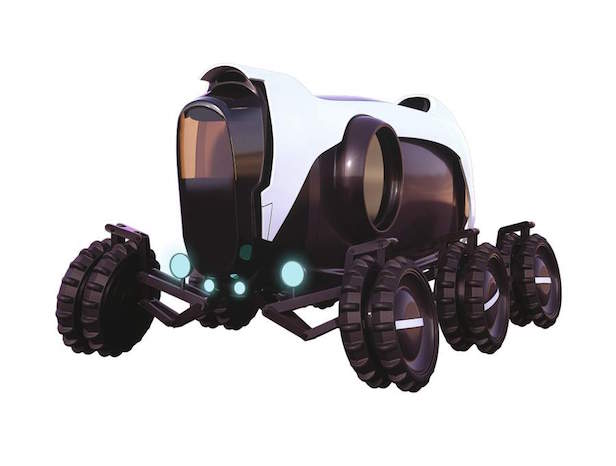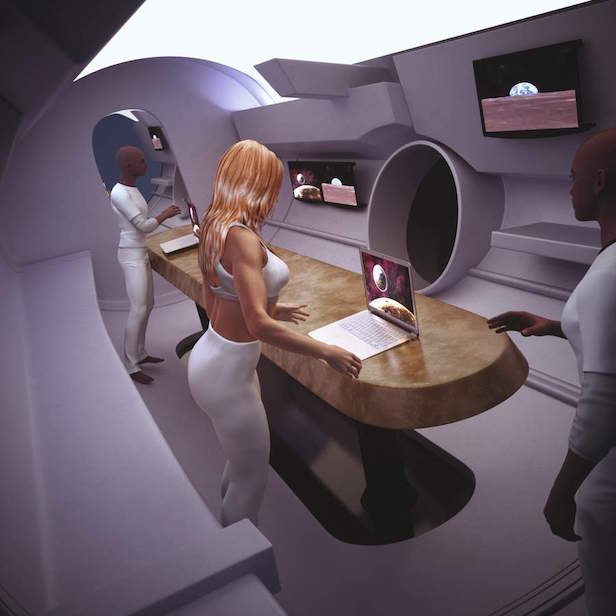Futuretech: Moonstream
NASA’s art and design outreach projects have produced a stylish Moon rover

The Moonstream’s body shape is inspired by a tortoise, a humpback whale and a giraffe!
NASA has a long history of looking to designers and engineers from outside the aerospace industry, in the interests of both broadening awareness of NASA and exploring ideas from other sectors. In the early 1970s they engaged Raymond Loewy’s then world-famous design studio to study how to make the Skylab space station and imminent Space Shuttle more pleasant spaces and less like one huge cockpit. Though the purely functional, maximalist interior of the current International Space Station demonstrates Loewy’s input ultimately came to nothing, NASA continues to look to the art and design sector for ideas.
A more recent Lunar Rover Design Challenge undertaken with the ArtCenter College of Design in Pasadena, California, has produced one of the best looking lunar rover concepts. The Moonstream, designed by Anthony Sims, was envisaged as a comfortable, aesthetic rover for Moon missions in the 2020s. Taking inspiration from nature, the form of the hull is apparently modelled after a combination of a tortoise shell and a humpback whale, with the “stance of a giraffe” when placed on its wheels. It consists of a central body about the size of an American school bus; this forms one large pressurised volume for a small team making a long journey across the Moon. The interior is intended to be as flexible as possible while retaining a high standard of design to promote crew wellbeing. The only fixed feature within the hull is an airlock and access point; renderings show a large airlock much more luxurious than Apollo’s small hatch, which should provide room for systems to keep the corrosive and smelly lunar dust from getting in. The driver is placed right in the nose of the vehicle and Sims has proposed an unusual approach to ensuring the driver has the best possible view of the potentially difficult terrain: prone position seating.

The access hatch has to allow for easy movement with bulky spacesuits and have facilities for keeping Moon dust outside – Apollo astronauts found it abrasive and smelly.
This is where the pilot lies forward on a reversed chair; it was mostly explored in the 1940s and 1950s as a way of allowing fighter pilots to cope with higher g-forces when manoeuvring. In the Moon stream it places the driver’s head right at the font of the vehicle in an outward leaning window, so they can have a completely unobstructed view forward and downward to the wheels, and the Moon stream will have 12 of those! The pressurised body will sit on a central chassis, which is intended to have six groups of twin wheels, attached to the chassis by adjustable suspension arms. These suspension arms would lift or drop individual wheel groups, push them out further from the body, or even change their angle (camber) in order to cope with any surface terrain the Moon could throw at the Moon stream. If things got really difficult, it is intended that the suspension arms could be moved forward and backward, as well as up and down, to walk forward like an insect with the wheels locked in place as feet.
The name seems to be inspired by the American Airstream caravans – the curvy, aerodynamic, shiny aluminium ones – and Sims has a big road trip in mind for his rover. “The Moon stream is the ultimate luxury space lounge, designed to change public perceptions of NASA and entice people to be more interested in a mission to the Moon,” he said. “It enables true comfort for inhabitants and provides an appealing setting for the daily lives of people on the first ever Moon road trip.”
Keep up to date with the latest news in All About Space – available every month for just £4.99. Alternatively you can subscribe here for a fraction of the price!




